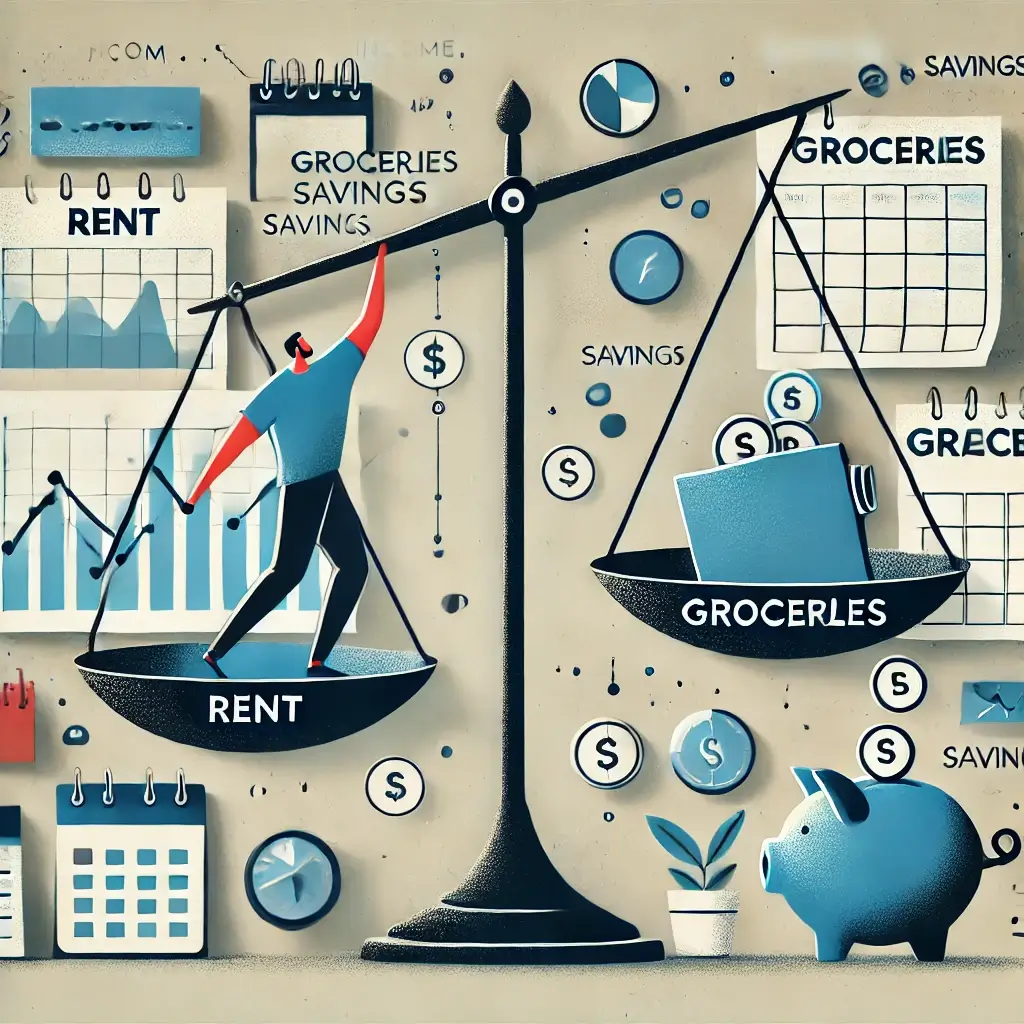Managing finances with an irregular income can feel like navigating a financial rollercoaster. Unlike traditional salaried jobs, irregular income budgeting—common among freelancers, gig workers, and entrepreneurs—requires a unique approach to budgeting. In this article, we’ll explore practical strategies to help you master irregular income budgeting, maintain financial stability, and grow your wealth, even when your income fluctuates.
Why Irregular Income Budgeting Is Different
Irregular income budgeting isn’t just about tracking expenses; it’s about planning for uncertainty. Without a steady paycheck, you need to account for periods of high and low cash flow, unexpected expenses, and long-term financial goals. The key is to create a flexible budget that adapts to your income while ensuring you can cover essential expenses and save for the future.
If you’re new to budgeting, start with our guide on Mastering the Basics of Budgeting: A Step-by-Step Guide to build a strong foundation.

Buffer Fund
What Is a Buffer Fund?
A buffer fund is a savings cushion designed to cover your baseline expenses during low-income periods. It’s a critical component of irregular income budgeting, acting as a financial safety net to reduce stress and prevent debt.
How to Build It
- Set a savings goal (e.g., 3-6 months of baseline expenses).
- Allocate a percentage of your income to the buffer fund during high-earning months.
- Keep the fund in a high-yield savings account for easy access and growth.
Why It Matters
A buffer fund provides peace of mind and ensures you can cover essential expenses even when income is unpredictable.
To maximize your savings, explore our guide on High-Yield Savings Accounts Explained: Maximize Your Returns.
Step 3: Use a Variable Budgeting Approach
What Is Variable Budgeting?
Variable budgeting is a flexible approach where you adjust your spending based on your monthly income. It’s ideal for irregular income budgeting because it adapts to fluctuations in cash flow.
How It Works
- Calculate your monthly income.
- Allocate funds to essential expenses first.
- Distribute the remaining income to discretionary spending, savings, and debt repayment.
Why It Matters
Variable budgeting ensures you live within your means, regardless of how much you earn each month.
For more budgeting strategies, visit Practical Budgeting Strategies: Tools, Tips, and Challenges.
Step 4: Leverage Budgeting Tools and Apps
Why Use Budgeting Tools?
Budgeting tools and apps simplify expense tracking, provide real-time insights, and help you stay on top of your irregular income budgeting plan.
Recommended Tools
- YNAB (You Need a Budget): Great for variable budgeting and goal setting.
- Mint: Tracks spending and categorizes expenses automatically.
- PocketGuard: This helps you manage cash flow and avoid overspending.
How to Get Started
- Choose a tool that aligns with your needs.
- Sync your bank accounts and credit cards.
- Set up categories for income and expenses.
For a detailed comparison of budgeting apps, check out our guide on Best Budgeting and Expense Tracking Apps.
Step 5: Plan for Taxes and Retirement
Why It’s Important
Irregular income budgeting often overlooks taxes and retirement savings, which can lead to financial stress down the road.
How to Plan
- Taxes: Set aside 25-30% of your income for taxes. Use a separate savings account to avoid spending it.
- Retirement: Contribute to a retirement account like an IRA or Solo 401(k). Automate contributions to ensure consistency.
Why It Matters
Planning for taxes and retirement ensures long-term financial stability and prevents unexpected liabilities.
Step 6: Adjust and Optimize Your Budget
Why Regular Reviews Are Essential
Your income and expenses may change over time, so it’s important to review and adjust your irregular income budgeting plan regularly.
How to Optimize
- Track your income and expenses monthly.
- Identify areas where you can cut back or reallocate funds.
- Update your budget to reflect changes in your financial situation.
For more tips on optimizing your budget, explore our article on Top Budgeting Methods: Incremental, Zero-Based, and Cash Flow.
Case Study: Freelancer Finds Financial Stability
Sarah, a freelance graphic designer, struggled with irregular income until she implemented irregular income budgeting strategies:
- She calculated her baseline expenses and built a buffer fund to cover 3 months of essentials.
- She used YNAB to create a variable budget, adjusting her spending based on monthly income.
- She set aside 30% of her income for taxes and automated retirement contributions.
Within a year, Sarah achieved financial stability and even saved enough for a down payment on a house.
Conclusion
Irregular income budgeting doesn’t have to be overwhelming. By calculating your baseline expenses, building a buffer fund, using a variable budgeting approach, and leveraging tools, you can create a flexible budget that adapts to your income fluctuations. Remember, the key to financial stability is planning, discipline, and regular reviews.
For additional insights on managing irregular income, check out this external resource from NerdWallet: How to Budget With a Fluctuating Income. It’s a comprehensive guide that complements the strategies discussed in this article.
Start implementing these irregular income budgeting strategies today, and take control of your financial future—no matter how unpredictable your income may be!
FAQs: Irregular Income Budgeting
1. Can I use irregular income budgeting if I have a part-time job?
Absolutely! Irregular income budgeting is ideal for anyone with fluctuating income, including part-time workers. The key is to calculate your baseline expenses, build a buffer fund, and adjust your spending based on your monthly earnings.
2. How do I handle irregular income budgeting during seasonal work?
For seasonal workers, irregular income budgeting is essential. During high-income seasons, prioritize saving for baseline expenses and building a buffer fund. During off-seasons, rely on your savings and adjust discretionary spending to match your reduced income.
3. What’s the best way to track irregular income?
Use budgeting apps like YNAB or Mint to track your income and expenses in real-time. These tools categorize your earnings and help you allocate funds effectively, making irregular income budgeting easier to manage.
4. How much should I save in my buffer fund?
Aim to save 3-6 months’ worth of baseline expenses in your buffer fund. This ensures you can cover essential costs during low-income periods without relying on credit or loans.
5. Can irregular income budgeting help me pay off debt?
Yes! Irregular income budgeting can help you allocate extra funds toward debt repayment during high-income months. Use a variable budgeting approach to prioritize debt payments while still covering essential expenses.
6. How do I budget for irregular income if I’m self-employed?
Self-employed individuals should focus on irregular income budgeting by:
- Setting aside 25-30% of income for taxes.
- Building a buffer fund for lean months.
- Using budgeting tools to track income and expenses.
7. What if my irregular income is unpredictable?
If your income is highly unpredictable, focus on building a larger buffer fund and using a conservative budgeting approach. Allocate funds to essential expenses first and save any surplus for future needs.
8. How do I budget for irregular income with a family?
For families, irregular income budgeting requires open communication and shared financial goals. Use a variable budgeting approach to allocate funds for essential family expenses, savings, and discretionary spending.
9. Can I invest while using irregular income budgeting?
Yes, but prioritize building a buffer fund and covering essential expenses first. Once you have a stable financial foundation, allocate a small percentage of high-income months toward investments.
10. How do I handle irregular income budgeting during emergencies?
Your buffer fund is your first line of defense during emergencies. If your fund is insufficient, adjust your budget by cutting discretionary spending and reallocating funds to cover urgent expenses.
11. What’s the difference between irregular income budgeting and traditional budgeting?
Traditional budgeting assumes a steady income, while irregular income budgeting focuses on flexibility and adaptability. It requires planning for fluctuations and prioritizing savings during high-income periods.
12. How do I stay motivated with irregular income budgeting?
Set clear financial goals, track your progress, and celebrate small wins. Use budgeting tools to visualize your achievements and remind yourself why irregular income budgeting is worth the effort.
13. Can I use irregular income budgeting for long-term financial goals?
Yes! Irregular income budgeting can help you save for long-term goals like buying a home or retiring. Allocate a portion of high-income months toward these goals and adjust your budget as needed.
14. What if I have multiple sources of irregular income?
Track each income source separately and use irregular income budgeting to allocate funds based on priority expenses. Tools like YNAB can help you manage multiple income streams effectively.
15. How do I teach my family about irregular income budgeting?
Involve your family in the budgeting process by:
- Explaining the importance of a buffer fund.
- Setting shared financial goals.
- Encouraging open communication about income and expenses.

